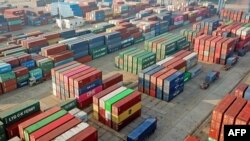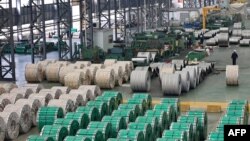Under former Chinese Communist Party leader Mao Zedong, local leaders who feared being branded as rightists falsified reports of grain production.
In a paper on China’s turbulence in the early 1960s, American researcher Clayton Brown wrote in 2012 that ranking party members seldom questioned political figures, either out of fear or ignorance.
That cycle may be repeating itself now, some economists warn, as China reports solid economic growth and industrial production figures, despite widespread COVID-19 lockdowns compounded by property market shocks and a tech sector crackdown in 2021.
“I think it’s a lot of weak reporting and politically motivated numbers from lower levels that the higher levels don’t know what to do about or don’t want to know,” said Adam McCarty, chief economist at Mekong Economics in Hanoi. “That remains a problem for China.”
The Chinese National Bureau of Statistics reported 4.8% year-on-year GDP growth in the January-March quarter of 2022. Industrial production expanded 6.5% in the same period compared to the first quarter of 2021, the bureau said this month.
Questions about economic data remained muted before the COVID-19 outbreak, as China’s expanding middle class and its boom in export manufacturing backed up the figures. But today’s headline data are rekindling doubt because of the $18.1 trillion economy’s list of problems.
“Now, with the latest GDP numbers, which seem very high, you have a chorus of economists outside China who are starting to say, ‘This doesn’t seem right. The numbers don’t add up,’ and who are indeed questioning the reliability of the statistics,” said Dexter Roberts, U.S.-based senior fellow at the Atlantic Council's Asia Security Initiative and author of “The Myth of Chinese Capitalism.”
Authorities in Shanghai have kept millions of people at home this month to stop the spread of COVID-19, impacting supply chains, factory production and shipping from the world’s largest seaport.
Chinese regulators had cracked down in late 2021 against tech icons such as Alibaba to stop what they called abuse of user data and monopolistic business practices.
In the property market, debt defaults have followed developers from last year into 2022, investment bank Goldman Sachs said in a March research note.
Grain output data passed up to Mao’s government gave an impression of success for the leader’s Great Leap Forward economic growth campaign, despite what later became known as a major famine, wrote Brown, an Asian-specialized assistant history professor at Utah State University.
Mao’s party remains in charge of China today.
“China has a long history of opaqueness when it comes to reporting economic statistics,” the Heritage Foundation research group said in a 2020 commentary.
Today’s Communist Party is chasing a strong GDP because it has “staked its legitimacy on successful handling of the pandemic,” Roberts said.
Examining more granular data
Traders, investors and others trying to grasp China’s economic reality use more granular data, said Alicia Garcia Herrero, chief Asia-Pacific economist at French investment bank Natixis. Monthly figures on trade, manufacturing, everyday consumption and joblessness say more than quarterly production or GDP figures, she said.
“You could say that high-frequency data shows a much worse picture, especially consumption, than GDP data. And that’s a fact,” she said.
Imports fell last month, and export growth slowed. The domestic Caixin China General Manufacturing PMI, a measure of confidence in factory production, hit a 25-month low in March. China is the world’s biggest manufacturing base. Home sales, retail transactions and joblessness all worsened in March.
But for the full quarter, trade in goods rose 10.7% year on year, and retail sales of consumer goods increased 3.3% compared to the first quarter of 2021. The quarter covers two months before lockdowns touched financial hub Shanghai and tech metropolis Shenzhen.
“Some figures may be made up, some cannot, such as export-import figures,” said Darson Chiu, deputy macroeconomic forecasting director at the Taiwan Institute of Economic Research. “Otherwise, they won’t add up when comparing with figures of other nations.”
Some figures contradict each other, Roberts said. Cement and steel output weakened in the first quarter, he said, while fixed-asset investment — the amount spent on construction, land, infrastructure and equipment — grew 9.3% over the same period.
Some parts of the economy are struggling, but it’s fundamentally hanging together, Chinese Embassy spokesperson Liu Pengyu told VOA.
“Due to the pandemic and other factors, several sectors in China have come under some pressure to maintain steady investment growth in the past two months,” Liu said. “However, as China's efforts to support the development of the real economy continue to intensify, industrial investment tends to keep growing.”
China remains strong structurally behind the COVID-19 crisis, economists believe. It’s a “leading” world market that remains attractive to Western brands despite growing barriers to entry, McCarty said.
The embassy spokesperson said foreign companies have “cast a vote of confidence” in the country’s economic future.












